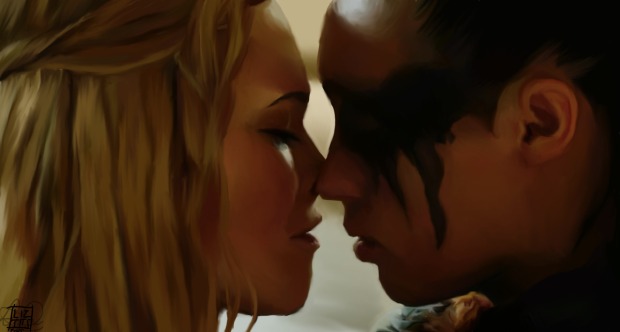Bury Your Gays: How a 1930s Hollywood Production Code is Killing Your Favorite LGBTQ Characters Today
Killing gay characters is not a new trend.

Clexa by liztits | Tumblr
Note: The following article contains spoilers for Buffy the Vampire Slayer, Orange is the New Black, and The 100.
If you’re an LGBTQ television fan, chances are you’ve seen your favorite lesbian character killed off — Tara McClay, Poussey Washington, Commander Lexa, just to name a few. And if you’re part of gay fandom culture, you might also be familiar with the #LexaDeservedBetter and #LGBTFansDeserveBetter hashtag riots when The 100 killed off their beloved lesbian warrior in 2016, even if you haven’t seen the show. Television fans have protested gay character deaths by tweeting, boycotting, and raising over $170,000 for The Trevor Project. But why are all the gay characters killed off in the first place? I have a hunch — a Hollywood production code from the 1930s could be responsible for killing your favorite gay characters today.
Are Gay Characters Really Dying More Than Straight Characters?
Before we get into the meat of the theory, we have to lay the groundwork. Yes, onscreen gay characters are dying at higher rates than straight characters. When you break it down into percentages, LGBTQ characters make up a tiny fraction of the characters across American networks. In GLADD’s 2017-2018 “Where We Are On TV” report, LGBTQ characters only made up 6.43% of all recurring characters on broadcast television networks. This small number is impactful. It tells us that, even if only a few queer characters die, it accounts for a huge portion of those represented on television at all.

“Where Are We On TV” Report © GLAAD 2017-2018
Another 2016 report by Autostraddle tallies the number of lesbians who die in off-air television shows from 1976 to 2016. This report reflects a 31% death rate for queer women onscreen. And even those who survive may not get a happy resolution: the study reports a mere 10% of gay women having positive closing arcs. The tiny number of LGBTQ characters in television and films directly influences how impactful gay character deaths are for queer communities.
What is the “Bury Your Gays” trope?
“Bury Your Gays” is a cliché that refers to killing off gay characters. That’s right, it happens so often that there’s a name for this tired plot device. Again, if you’re part of queer-dominated fandoms like Supergirl and The Bold Type, you’ve likely become familiar with the trope after Lexa’s death on The 100. In 2016 and 2017, 67 queer characters were killed off on television alone, bringing this trope into the limelight of social media hashtag campaigns. This attention even expanded beyond fandom circles and into mainstream news outlets like USA Today and BBC News.
The Hays Code: Why Gay Characters are Killed Off
Killing gay characters is not a new trend. Ever since LGBTQ characters made their legal debut in Hollywood films of the 1960s (gay characters were heavily coded as such in earlier films, despite being prohibited), they’ve been targeted for death and tragedy arcs. But why?
In early Hollywood, studios and audiences alike viewed films as products for consumers, rather than art for expression. Therefore, certain moviegoers formed a group that demanded regulation of Hollywood films in order to reduce the risk of exposing people to content that the group deemed immoral. And since the group in question were heavily influenced by the values of the Catholic religion, you can imagine why homosexual characters made the list of things banned from Hollywood films (in addition to white slavery, profanity, and sex). This prohibition, the Hays Code, ran from 1934 until the 1960s and worked to uphold a sense of (Catholic) morality in American cinema.
When the Hays Code became more relaxed in the 1960s, gay characters emerged, however they were usually written with closing story arcs of death or trauma. This was no coincidence. Filmmakers began integrating gay characters in ways that audiences deemed acceptable. Ultimately, that meant punishment for their “crimes,” which often unfolded in their death. The sense of morality in the Hays Code left remnants of a need to reinforce a Catholic right and wrong, even after the Code was no longer formally enforced. As a result, most of the first homosexual characters in Hollywood films were killed off or suffered other tragic endings. (For more information, see the documentary The Celluloid Closet.)
Is There a Happy Ending for LGBTQ Characters?
Unfortunately, onscreen stories treat LGBTQ characters in much the same way even five decades later. Many contemporary queer characters on television are killed off, with more of them dying than surviving. However, it’s improbable that today’s writers are purposefully intending to replicate the Hays Code’s crime and punishment dynamics. The continued use of the “Bury Your Gays” trope likely deals more with a repetitive fallback that most writers aren’t quite aware of when making the decision to end an LGBTQ character’s story.
Thankfully, fandom culture has spread this awareness across the internet for cishet audiences and writers to consider, and they’ve reached back. In 2016, a small group of TV writers and producers began a pledge that calls for television creatives to be mindful of LGBTQ fandoms when creating content that represents them — including a clause that states they will not kill off LGBTQ characters to further the story of a straight character. Since then, over a dozen TV executives have taken the pledge, furthering the effort in Hollywood to provide positive representation for LGBTQ audiences. It is this kind of collaboration between creators and viewers that generates rich content and representation that betters our community.

Leave a comment